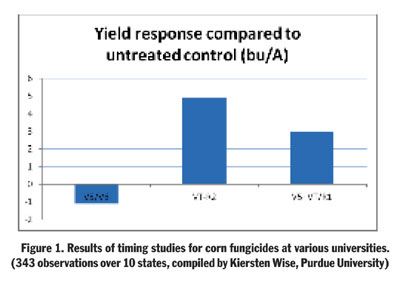Timing Fungicide Sprays In Corn
LEXINGTON, KY.
Application of strobilurin
fungicides to foliage has
been shown to improve
agronomic performance in
some situations. Yield increases
and other agronomic
benefits may result from disease
control and/or from
physiological effects induced
by the active ingredient.
Regarding fungicides, the first question a producer
decides is whether or not to
apply a product. If s/he decides to
apply one, then the next question is,
“When do I apply it?”
In university tests over several
years, it is common to see much more
benefit to application made at VT-R2,
then early in the season. See results
from last year (Fig. 1), as an example.
Last year’s results also show no economic
benefit to two applications vs.
one, which again is pretty typical of
university results generally. There
may be exceptions to these trends,
but that is what they are: exceptions
to the more general trends.

I have also heard of fields receiving
three and four applications of strobilurin
fungicides in commercial fields
(not necessarily in Kentucky). Since two applications
do not consistently provide measurable
benefit over and above that provided by one application,
I am curious whether multiple applications
really are beneficial. Plus, strobilurin
products have label restrictions on the number
of permissible sequential applications without
using a fungicidal product not in Group 11.
Bottom line: If using a corn fungicide, university
research continues to highlight that one application
made at VT/R1 is the optimal use. Δ
DR. PAUL VINCELLI: Extension Plant Pathologist,
University of Kentucky